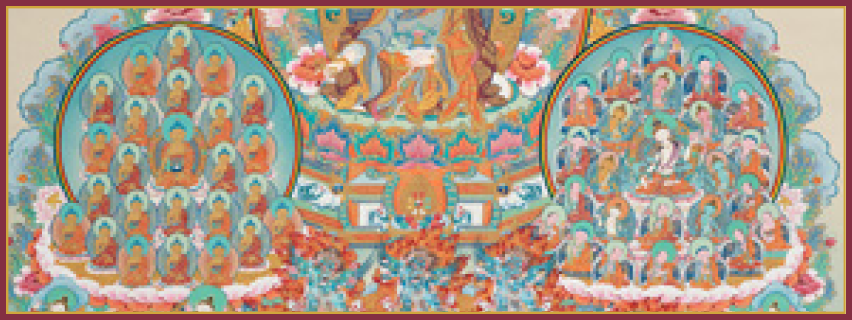No Artist found.
Origin:
This thangka represents the visualization used in the ‘Preliminary Practices’ (ngondro) of the Dudjom Tersar tradition.
Revelation:
The teachings were revealed by Dudjom Lingpa (1835-1904) and his subsequent incarnation, Dudjom Rinpoche, Jigdral Yeshe Dorje (1904-1987).
Foundation:
Based on teachings originally composed by Padmasambhava in the ninth century and concealed as treasures (terma) to be revealed later when the Dharma practice became degenerate.
Purpose:
The Refuge Tree is visualized during the ngondro practices to establish a connection with the lineage and receive blessings.
Lineage:
Emphasizes an unbroken, direct transmission lineage from Padmasambhava, ensuring the teachings’ authenticity and potency.
Position:
Top of the Refuge Tree.
Depiction:
Seated on a lotus and lion throne, wearing a lotus-hat and three robes, representing the mastery of the three Buddhist yanas (Hinayana, Mahayana, and Vajrayana).
Symbolism:
Padmasambhava’s central position signifies his importance in the Dudjom Tersar tradition.


Sequence:
Ten cloud-borne gurus descending from Samantabhadra to Dudjom Rinpoche.
Depictions:

Depiction:
Extremely fierce, with three heads, four legs, and six arms, standing in alidha posture with consorts.
Attributes:
Each deity holds specific items and wears the ‘ten attires of the charnel grounds’.
Deities:

Depiction:
Extremely fierce, with three heads, four legs, and six arms, standing in alidha posture with consorts.
Attributes:
Each deity holds specific items and wears the ‘ten attires of the charnel grounds’.
Deities:

Left Branch:
Shakyamuni Buddha with twenty-four other Buddhas, representing the thousand Buddhas of our era.
Standing Figure Below:
Vidyadhara Heruka embracing his consort.

Central Figure:
Avalokiteshvara.
Surrounding Bodhisattvas:

Assembly:
Sixteen Noble Elders with one attendant, Upasaka Dharmatala.
Arhats:

Assembly:
Principal male and female protector deities of the Nyingma tradition, known as ‘The Assembly of Haughty or Arrogant Deities that are Oath-bound to the Three Inner Tantras’.
Deities:
Dudjom Rinpoche on Ngondro:
“This is a condensed version of the preliminary practices that clearly elucidates their essential meaning, and is intended for those who do not fully understand or are unable to perform the extensive preliminary practices.”
Lama Tharchin Rinpoche on the Dudjom Tersar Lineage:
“The Dudjom Tersar lineage is fresh, vivid and direct, with no loss of meaning, words or blessing. These teachings, coming directly from Guru Rinpoche to Dudjom Rinpoche, and then to us, are a direct short lineage. Therefore, because this lineage is uncontaminated and knows no degeneration by broken samayas, the blessing and attainments are immediate.”
Collection of most exclusive thangkas from top thangka and paubha artists in Nepal

Thangkas are intricate and vibrant Tibetan Buddhist scroll paintings, highly revered for their cultural significance and the exceptional craftsmanship invested in their creation.
Thangkaa.com carries a diverse inventory of art styles, including Paubha, Tibetan, Mandala, and more.
Yes, all thangkaas on Thangkaa.com have been quality assured and verified for authenticity by experts.
Thangkaa.com features artists from around the globe, showcasing a wide range of talent and styles.
We offer a 30-day money-back guarantee. If you're not satisfied with your purchase, you can return it within 30 days for a full refund.
No, Thangkaa.com is an e-commerce platform that connects you directly with thangkaa artists, eliminating middlemen.
